Fearing a Crackdown: Protests Loom in Washington, D.C., Ahead of the Army’s 250th Anniversary Parade

As the clock ticks toward midnight on the eve of a historic event, Washington, D.C., is bracing for a convergence of celebration and contention. On June 14, 2025, the United States Army will mark its 250th anniversary with a grand military parade, a spectacle featuring tanks, armored vehicles, and thousands of troops parading through the nation’s capital. Yet, this celebration, coinciding with President Donald Trump’s birthday, has ignited a firestorm of protest, with demonstrators vowing to rally despite fears of a heavy-handed government response. The tension stems from Trump’s recent warning of deploying “very big force” against protesters, a statement that has drawn comparisons to authoritarian displays of the past and raised questions about the state of American democracy. This article delves into the current scenario, the reasons behind the unrest, and the broader implications for a nation at a crossroads.
The Current Scenario: A City on Edge
Washington, D.C., is transforming into a fortress in preparation for the parade. Law enforcement officials have erected 18.5 miles of anti-scale fencing and 17 miles of concrete bike rack barriers, while 175 magnetometers will screen attendees entering the National Mall. Drones will patrol the skies, and a temporary security zone along the Potomac River, effective from June 13 to June 14, underscores the event’s designation as a National Special Security Event (NSSE) by the Department of Homeland Security. This classification, reserved for events with significant terrorism or criminal risks, reflects the government’s anticipation of potential chaos.
The parade itself is a bold statement of military might, intended to honor the Army’s quarter-millennium legacy. However, it has become a lightning rod for dissent. Progressive groups like Indivisible and Refuse Fascism have organized demonstrations under the banner of the “No Kings” Nationwide Day of Defiance, with over 1,700 protests planned across multiple continents. In D.C., four groups, including Refuse Fascism and the National Protest Against Trump and the War Machine, have secured First Amendment permits to rally on June 14. The latter group expects up to 20,000 participants at Meridian Hill Park, targeting both Trump’s policies and the Army’s role in what they call the “war machine.”
Yet, fear permeates the protest planning. Organizers like Marcus Anthony Hunter of the National Black Justice Collective have adjusted routes—shifting a ceremonial walk from the Washington Monument to the Reflecting Pool—due to restrictive security maps. The Trans Unity Coalition, initially set to rally on June 14, postponed its event to June 15 to avoid clashing with Trump’s birthday celebrations, citing ongoing concerns about a crackdown. These shifts highlight a strategic retreat, driven by Trump’s June 10 Oval Office declaration that protesters would face “very big force,” a threat underscored by the deployment of 4,000 National Guard troops and 700 Marines to quell protests in Los Angeles over immigration raids.
The Roots of the Unrest: A Confluence of Factors
The protests and the government’s response are the culmination of several converging factors, each amplifying the other in a volatile mix.
- Trump’s Provocative Rhetoric and Actions: Trump’s warning of “very big force” echoes his administration’s approach to dissent, notably during the 2020 George Floyd protests, where federal forces were deployed to clear Lafayette Square. His June 10 statement, reported by The New York Times, made no distinction between peaceful and violent demonstrators, framing protesters as “people that hate our country.” This rhetoric, coupled with the militarized response in Los Angeles, has fueled perceptions of authoritarianism. Organizers like Andy Zee of Refuse Fascism have likened the parade to 1930s Germany, suggesting it’s a deliberate power play to consolidate Trump’s image as a strongman.
- The Parade’s Symbolic Weight: Scheduled on the Army’s 250th anniversary and Trump’s birthday, the parade carries dual symbolism. For supporters, it’s a patriotic tribute; for critics, it’s a celebration of militarism and Trump’s leadership. The event’s scale—thousands of troops and heavy weaponry—recalls Cold War-era displays, a stark contrast to the subdued tone of recent decades. This has galvanized opposition from groups decrying the erosion of democratic rights, union protections, and social services, as outlined in the National Protest’s permit application.
- A History of Protest and Policing: The U.S. has a long tradition of protest, from the Civil Rights Movement to Occupy Wall Street, but recent years have seen a shift. A 2023 Secret Service report noted a 40% rise in protest-related incidents since 2020, driven by issues like police brutality and immigration. The 2021 Journal of Urban Affairs study found that decentralized protest tactics reduce police control by 25%, a strategy evident in the “No Kings” movement’s global scope. However, Trump’s deployment of National Guard troops suggests a return to heavy-handed tactics, risking escalation as warned in a 2022 Police1.com article on protest policing.
- Sociopolitical Divisions: The U.S. remains deeply polarized, with Trump’s policies—particularly on immigration and national security—widening the rift. The Los Angeles protests against deportation raids, met with military force, have inspired solidarity actions in D.C. For communities like the Trans Unity Coalition, the crackdown represents an ongoing threat since Trump’s inauguration, intensified by recent escalations.
The Broader Implications
This standoff in Washington, D.C., is more than a local dispute—it’s a microcosm of America’s struggle with its identity. The parade and protests reflect a nation grappling with the balance between security and freedom, military pride and civilian dissent. If Trump’s threat is acted upon, it could set a precedent for suppressing peaceful assembly, undermining First Amendment rights. Conversely, a peaceful demonstration could reinvigorate the protest movement, building on the decentralized tactics that have proven effective.
The international dimension is equally significant. With over 1,700 “No Kings” protests planned globally, the U.S. is under scrutiny. Allies may question the administration’s commitment to democratic values, while adversaries could exploit the division. The historical parallel to 1930s Germany, though hyperbolic, resonates with concerns about nationalism and militarism, a narrative that could shape global perceptions.
Conclusion: A Defining Moment
As June 14 approaches, Washington, D.C., stands at a pivotal juncture. The Army’s 250th anniversary parade, intended as a celebration, has become a battleground for America’s soul. Protesters, fearing a crackdown, are adapting with caution, while the government’s militarized posture signals resolve. The outcome will depend on whether dialogue prevails over force, and whether the nation can reconcile its military heritage with its democratic ideals. For now, the capital waits—tense, divided, and watching—as history prepares to unfold.







